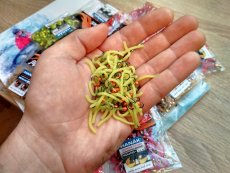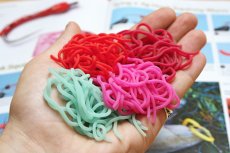In this article, you will learn everything you need to know about all the worm patterns so popular today, although still very controversial "artificial flies" that are effective both on the river and on the stillwater when fishing for salmonid, coarse fish!
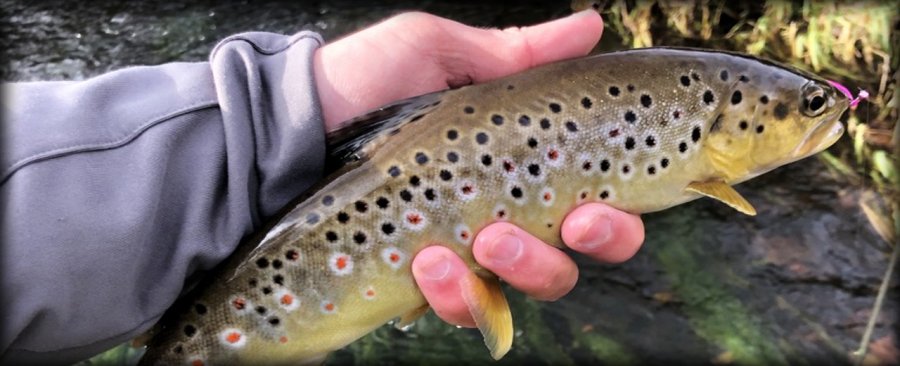
Worm imitations have been encountered in modern fly fishing for a relatively long time! Such a first attempt at imitations was the Polish "Glajchs", which brought a great advantage in murky water compared to other flies. It is a very hard-working fly to tie, and its concept really resembles an earthworm. But in 2014, everything changed.
At the World Junior Championship in Poland, the American team brought a completely different prototype of imitation worms, namely Squirmy Wormy, which were ultimately much more successful than the aforementioned Polish Glajchs. These American Squirmy Wormy patterns were originally made from a children's ball that had long rubber tassels. The great advantage of these patterns is the softness of the material used, which ensures great mobility for the fly. This also immediately marked the results of the World Championship, when the Americans sovereignly took first place and also the first two individual medals. Not only did squirms catch more fish, they caught bigger fish. It is not a problem to convince even the biggest graylings to use these "fly" patterns, which in most cases are not outsmarted by even the most experienced fly anglers.
But it wouldn't be a fly rod if the further development of this lure did not follow. This came in 2019, when chenille worms were created mainly due to the fact that FIPS prohibited fishing on rubber materials up to 1 cm. The Czech junior national team at the championship in Bohemia came to the so-called Juan de Worm chenille earthworms. This type of lure helped in a big way to our junior fly fishing title. Finally, Juan de Worms are even better due to their lifespan, which is much longer than that of Squirmy Worms, where the tail often fails and breaks away from the body. The ideal material for tying these worms is Micro Chenille FlyBox Eggstasy NANO (round) or Flat Chenille Tommi-Fly Micro UV (flat). At this moment, we can already meet many types of earthworms, such as Chamois Worms, which are made from finely worked deer skin - chamois, or Chewing Gum Worms from special Stretch Worm Chenille, e.g. from Veniard, created from a mast wick of Flexi Floss rubber bands and they are fished with them mainly on still water using the static BUNG method with a strike indicator.
Tying such a fly is very simple and it doesn't matter what material we tie - the principle is basically the same! We choose a quality jig hook, e.g. H450BL, which has a suitable shape and is very strong, then the right tungsten head that corresponds to the size of the fly. The most important thing is to choose the material from which you want to make the tail = the body of the fly. We have allowed ourselves to help you with this and have selected materials that are proven and work great, e.g. Squirmy Legs or Micro Squirmy Tails from the FlyBox brand, or Worm Body from Veniard.
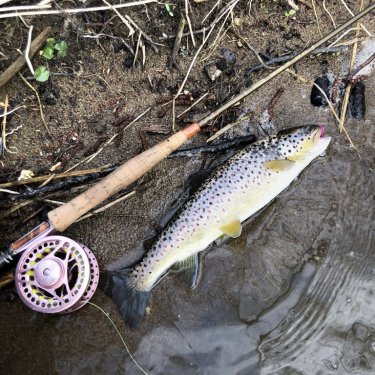
If we want to tie Squirmy Wormy, it is important to watch out for two things. The first thing we have to be careful about is that we always use elastic threads, other threads usually cut through the soft silicone material. Secondly: Squrims are not very friendly with chemical products, therefore we do not use lacquer to etch the fly. All you have to do is attach the tail firmly and then make a body with a few wraps, for example from the rest of the tail or some dubbing, and the fly is ready. For those of you who don't tie flies yourself, you don't have to despair, here you will find a lot of different Squirmy Wormy effective patterns.
These worms are mostly fished with the help of a French leader, when the worm is finally given to a leader with a heavier head. With this style, it seems to "clink" along the river bottom. It also works well to cast an worm with a lighter head upstream and let it drift freely with the current. It's all about trying to play around with this lure on the water during the actual hunt and see what style works best for you! The instructions mentioned are just basic tips on how to do it.
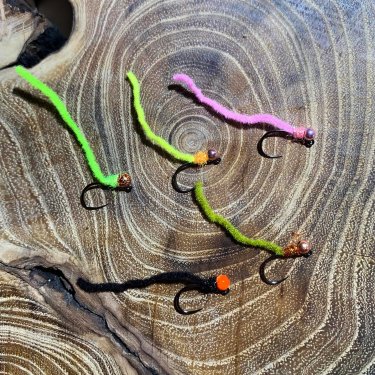
This innocent-looking "artificial fly" became a phenomenon within a few years, and nowadays there are very few fly fishermen who do not catch worms on Squirmy Wormy or other imitations. Here, however, comes the question of whether it is really correct/fly fishing for such a bait? Isn't it more UL spinning than fly fishing?
But everyone should ask such questions in their own head! Fishing for worms is certainly easier than figuring out which nymph, wet or dry fly to tie at the given moment and according to the given conditions, but it is no coincidence that this is precisely the beauty of fly fishing - inventing different ways to outwit the fish, rather than headlong tossing this bizarre rubber bait. Everyone has to figure that out for themselves! 😉












